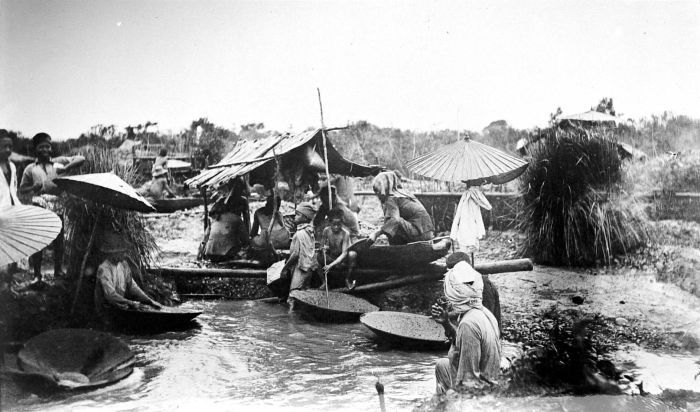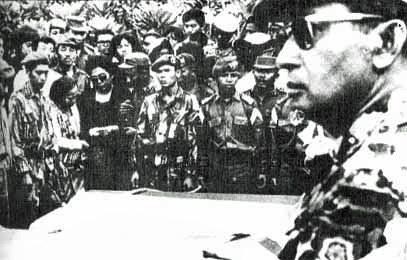|
Mess L
Mess L, officially known as Dekranasda Creative Hub, is a multipurpose building located in the city of Banjarbaru, Indonesia. Located in Komet subdistrict, North Banjarbaru district, it was formerly a building used by Soviet workers as homebase to assist development of steel industry in the then-newly built city. The Soviet workers left the city in 1965 due to transition to the New Order, resulting in cancelation of the project and abandonment of the building. The building was left crumbling down and overgrown by vegetation until 2017 when it was renovated and repurposed as a creative economy center and multipurpose building. History Banjarbaru was a relatively new city built with the purpose of replacing Banjarmasin as the new capital of the then-single Kalimantan province to avoid frequent flooding. Sukarno, Indonesia's first president, wanted the city to be a new steel industry center in the region and requested assistance from the Soviet Union to develop the industry. T ... [...More Info...] [...Related Items...] OR: [Wikipedia] [Google] [Baidu] |
Banjarbaru
Banjarbaru is the capital city of South Kalimantan, one of the provinces in Indonesia. It is located southeast of Banjarmasin, the largest city of the province. The city had a population of 248,423 as of the 2017 Census, and the latest official population estimate (as of 2019) is 262,719. The town of Martapura lies immediately to the north of Banjarbaru, and in effect constitutes an extension of the city. The second largest city in the province after Banjarmasin, it is also part of Banjarbakula metropolitan area. History Etymology Banjarbaru was previously only a temporary name used by governor Dr. Murdjani to differentiate it from Banjarmasin, as "baru" means "new" in Indonesian. However, the name stuck between people living there and gradually became official name of the city. Banjarbaru previously consisted of a series of hills known as Mount Apam. Early history Diamond mines in Cempaka have existed since the 15th century under the Hindu-Buddhist kingdom Negara Di ... [...More Info...] [...Related Items...] OR: [Wikipedia] [Google] [Baidu] |
Transition To The New Order
Indonesia's transition to the New Order in the mid-1960s ousted the country's first president, Sukarno, after 22 years in the position. One of the most tumultuous periods in the country's modern history, it was the commencement of Suharto's 31-year presidency. Described as the great ''dhalang'' ("puppet master"), Sukarno drew power from balancing the opposing and increasingly antagonistic forces of the army and Indonesian Communist Party (PKI). By 1965, the PKI extensively penetrated all levels of government and gained influence at the expense of the army. On 30 September 1965, six of the military's most senior officers were killed in action (generally labelled an "attempted coup") by the so-called 30 September Movement, a group from within the armed forces. Within a few hours, Major General Suharto mobilised forces under his command and took control of Jakarta. Anti-communists, initially following the army's lead, went on a violent purge of communists throughout the coun ... [...More Info...] [...Related Items...] OR: [Wikipedia] [Google] [Baidu] |
Mess L Before Renovation
The mess (also called a mess deck aboard ships) is a designated area where military personnel socialize, eat and (in some cases) live. The term is also used to indicate the groups of military personnel who belong to separate messes, such as the officers' mess, the chief petty officer mess, and the enlisted mess. In some civilian societies this military usage has been extended to the eating arrangements of other disciplined services such as fire fighting and police forces. The root of ''mess'' is the Old French ''mes'', "portion of food" (cf. modern French ''mets''), drawn from the Latin verb ''mittere'', meaning "to send" and "to put" (cf. modern French ''mettre''), the original sense being "a course of a meal put on the table"; cfr. also the modern Italian ''portata'' with the same meaning, past participle of ''portare'', ''to bring''. This sense of ''mess'', which appeared in English in the 13th century, was often used for cooked or liquid dishes in particular, as in the "mess o ... [...More Info...] [...Related Items...] OR: [Wikipedia] [Google] [Baidu] |
Banjarmasin
) , translit_lang1 = Other , translit_lang1_type1 = Jawi , translit_lang1_info1 = بنجر ماسين , settlement_type = City , motto = ''Kayuh Baimbai'' ( Banjarese: 'Rowing Together') , image_skyline = , image_caption = Clockwise from top: Banjarmasin seen from above, Soetji Nurani Chinese Temple, Banjarmasin watchtower, and Banjarmasin floating market. , image_flag = Flag of Banjarmasin City.png , image_shield = Lambang Kota Banjarmasin.gif , image_map = , mapsize = , map_caption = Interactive map outlining Banjarmasin , pushpin_map = Indonesia , pushpin_label_position = right , pushpin_map_caption = Location within Indonesia , subdivision_type = Country , subdivision_name = Indonesia ... [...More Info...] [...Related Items...] OR: [Wikipedia] [Google] [Baidu] |
Kalimantan
Kalimantan () is the Indonesian portion of the island of Borneo. It constitutes 73% of the island's area. The non-Indonesian parts of Borneo are Brunei and East Malaysia. In Indonesia, "Kalimantan" refers to the whole island of Borneo. In 2019, President of Indonesia Joko Widodo proposed that Capital of Indonesia, Indonesia's capital be moved to Kalimantan, and in January 2022 Indonesian legislature approved the proposal. The shift is expected to take up to 10 years. Etymology The name ''Kalimantan'' is derived from the Sanskrit word ''Kalamanthana'', which means "burning weather island", or island with a very hot temperature, referring to its hot and humid tropical climate. It consists of the two words ''Kāla (time), kal[a]'' ("time, season, period") and ''manthan[a]'' ("boiling, churning, burning"). The indigenous people of the eastern region of Borneo referred to their island as ''Pulu K'lemantan'' or "Kalimantan" when the sixteenth century Portuguese explorer Jorge de Meneze ... [...More Info...] [...Related Items...] OR: [Wikipedia] [Google] [Baidu] |
Sukarno
Sukarno). (; born Koesno Sosrodihardjo, ; 6 June 1901 – 21 June 1970) was an Indonesian statesman, orator, revolutionary, and nationalist who was the first president of Indonesia, serving from 1945 to 1967. Sukarno was the leader of the Indonesian struggle for independence from the Dutch colonialists. He was a prominent leader of Indonesia's nationalist movement during the colonial period and spent over a decade under Dutch detention until released by the invading Japanese forces in World War II. Sukarno and his fellow nationalists collaborated to garner support for the Japanese war effort from the population, in exchange for Japanese aid in spreading nationalist ideas. Upon Japanese surrender, Sukarno and Mohammad Hatta declared Indonesian independence on 17 August 1945, and Sukarno was appointed president. He led the Indonesian resistance to Dutch re-colonisation efforts via diplomatic and military means until the Dutch recognition of Indonesian independence ... [...More Info...] [...Related Items...] OR: [Wikipedia] [Google] [Baidu] |
Soviet Union
The Soviet Union,. officially the Union of Soviet Socialist Republics. (USSR),. was a transcontinental country that spanned much of Eurasia from 1922 to 1991. A flagship communist state, it was nominally a federal union of fifteen national republics; in practice, both its government and its economy were highly centralized until its final years. It was a one-party state governed by the Communist Party of the Soviet Union, with the city of Moscow serving as its capital as well as that of its largest and most populous republic: the Russian SFSR. Other major cities included Leningrad (Russian SFSR), Kiev (Ukrainian SSR), Minsk ( Byelorussian SSR), Tashkent (Uzbek SSR), Alma-Ata (Kazakh SSR), and Novosibirsk (Russian SFSR). It was the largest country in the world, covering over and spanning eleven time zones. The country's roots lay in the October Revolution of 1917, when the Bolsheviks, under the leadership of Vladimir Lenin, overthrew the Russian Provisional Government ... [...More Info...] [...Related Items...] OR: [Wikipedia] [Google] [Baidu] |
Suharto
Suharto (; ; 8 June 1921 – 27 January 2008) was an Indonesian army officer and politician, who served as the second and the longest serving president of Indonesia. Widely regarded as a military dictator by international observers, Suharto led Indonesia through a dictatorship for 31 years, from the fall of Sukarno in 1967 until his own resignation in 1998. The legacy of his 31-year rule, and his US$38 billion net worth, is still debated at home and abroad. Suharto was born in the small village of Kemusuk, in the Godean area near the city of Yogyakarta, during the Dutch colonial era. He grew up in humble circumstances. His Javanese Muslim parents divorced not long after his birth, and he lived with foster parents for much of his childhood. During the Japanese occupation era, Suharto served in the Japanese-organized Indonesian security forces. During Indonesia's independence struggle, he joined the newly formed Indonesian Army. There, Suharto rose to the rank of major g ... [...More Info...] [...Related Items...] OR: [Wikipedia] [Google] [Baidu] |
New Order (Indonesia)
The New Order ( id, Orde Baru, abbreviated ''Orba'') is the term coined by the second Indonesian President Suharto to characterise his administration as he came to power in Transition to the New Order, 1966 until his Fall of Suharto, resignation in 1998. Suharto used this term to contrast his presidency with that of his predecessor Sukarno (retroactively dubbed the "Old Order," or ''Orde Lama''). Immediately following the 30 September Movement, attempted coup in 1965, the political situation was uncertain, Suharto's New Order found much popular support from groups wanting a separation from Indonesia's problems since its independence. The 'generation of 66' (''Angkatan 66'') epitomised talk of a new group of young leaders and new intellectual thought. Following Indonesia's communal and political conflicts, and its economic collapse and social breakdown of the late 1950s through to the mid-1960s, the "New Order" was committed to achieving and maintaining political order, econom ... [...More Info...] [...Related Items...] OR: [Wikipedia] [Google] [Baidu] |
Indonesian Air Force
The Indonesian Air Force ( id, Tentara Nasional Indonesia Angkatan Udara (TNI-AU), literally "''Indonesian National Military-Air Force''") sometimes shortened as IDAF / IdAF, is the aerial branch of the Indonesian National Armed Forces. The Indonesian Air Force is headquartered in Jakarta, Indonesia and is headed by the Chief of Staff of the Air Force ( id, Kepala Staf Angkatan Udara – KSAU or KASAU). Its order of battle is split into three Air Operations Commands ( id, Komando Operasi Udara). Most of its airbases are located on the island of Java. The Indonesian Air Force also has its ground force unit, called Air Force Quick Reaction Force Command (Kopasgat). The corps is also known as the "Orange Berets" () due to the distinctive color of their service headgear. The Indonesian Air Force has 37,850 personnel and equipped with 110 combat aircraft. The inventory includes five Su-27 and eleven Su-30 as the main fighters (from Russia) supplemented by 33 F-16 Fighting Falco ... [...More Info...] [...Related Items...] OR: [Wikipedia] [Google] [Baidu] |





